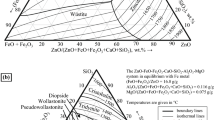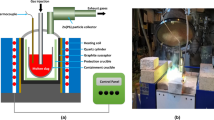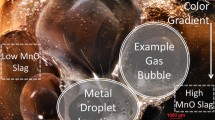Abstract
In the final part of this paper the mathematical model of the slag fuming process, developed in Part II based on the analysis of industrial measurements from Part I, has been subjected to a sensitivity analysis, then employed to elucidate the rate limiting steps and to predict the influence of process variables on fuming. The kinetics analysis has been based on model predictions of fuming efficiency (Zn/coal) of the coal particles injected into the slag. The model predicts that fuming efficiency passes through a maximum with increasing residence time of coal particles in the slag. At shorter times, the zinc reduction kinetics are governed by the Boudouard Reaction, but at longer times, beyond the time at which the peak fuming efficiency is reached, the diffusion of ferric iron to the interface between the secondary bubbles containing the coal and the slag is rate determining. The level of ferric iron in the slag, which depends on ferrous iron oxidation rate, melting/freezing of slag at the water-cooled jacket, and ferric iron reduction by coal entrained in the slag, is therefore an important variable affecting the fuming kinetics. With respect to the influence of manipulable process variables, the model predicts that zinc fuming can be enhanced by increasing the fraction of coal entrained by the bath up to an optimum value at a fixed coal rate. An increase in entrainment could be achieved by injecting the desired portion of the coal at high pressure and solids loading through a small number of tuyeres. This strategy is preferable, from the standpoint of fuming efficiency, to simply increasing the rate of coal injection at normal pressures. Similarly, there is an optimum charge weight and bath height for a given furnace size. The best coal for zinc fuming, according to the model, has the following properties: low moisture and ash content, high fixed carbon (or volatiles), and high reactivity. Model predictions also suggest that there are advantages to fuming in a continuous operation rather than in a batch mode.
Similar content being viewed by others
References
G.G. Richards and J.K. Brimacombe:Metall. Trans. B, 1985, vol. 16B, pp. 529–40.
G. G. Richards, J. K. Brimacombe, and G. W. Toop:Metall. Trans. B, 1985, vol. 16B, pp. 513–27.
H. H. Kellogg:Eng. Mining J., 1957, vol. 158, no. 3, pp. 90–92.
H.H. Kellogg:Trans. TMS-AIME, 1967, vol. 239, pp. 1439–49.
G. A. Yurko:Extractive Metallurgy of Lead and Zinc, C. H. Catterill and J.M. Cigan, eds., AIME, New York, NY, 1970, vol. II, pp. 330–47.
R.R. McNaughton:Trans. AIME, 1936, vol. 121, pp. 721–36.
D.R. Blaskett:Proc. Ninth Commonwealth Mining and Metallurgical Congress 1969, Mineral Processing and Extractive Metallurgy, M.J. Jones, ed., IMM, London, 1970, vol. 3, pp. 879–89.
Author information
Authors and Affiliations
Additional information
Formerly Graduate Student
Rights and permissions
About this article
Cite this article
Richards, G.G., Brimacombe, J.K. Kinetics of the zinc slag-Fuming process: Part III. model predictions and analysis of process kinetics. Metall Trans B 16, 541–549 (1985). https://doi.org/10.1007/BF02654852
Received:
Issue Date:
DOI: https://doi.org/10.1007/BF02654852




